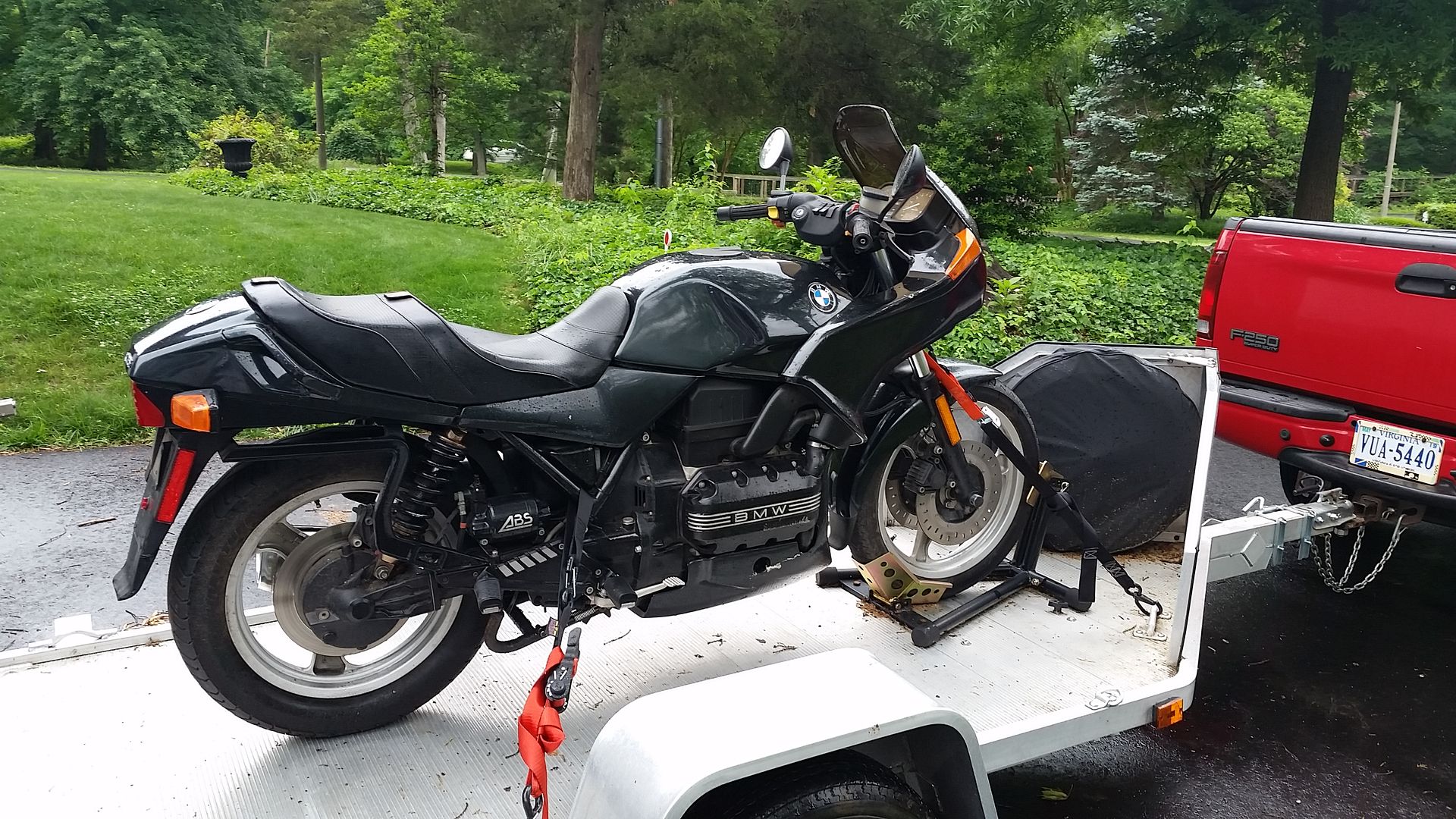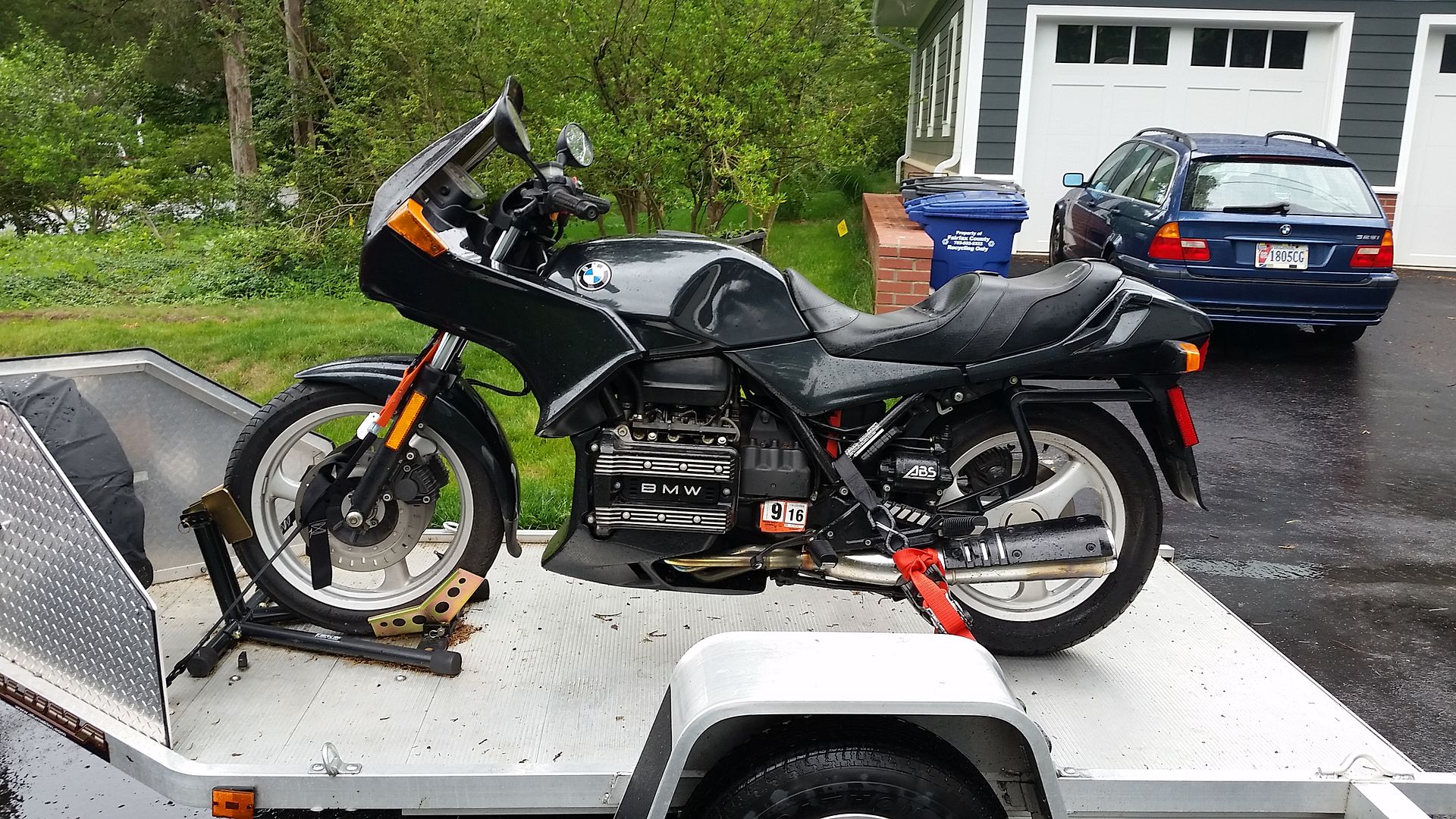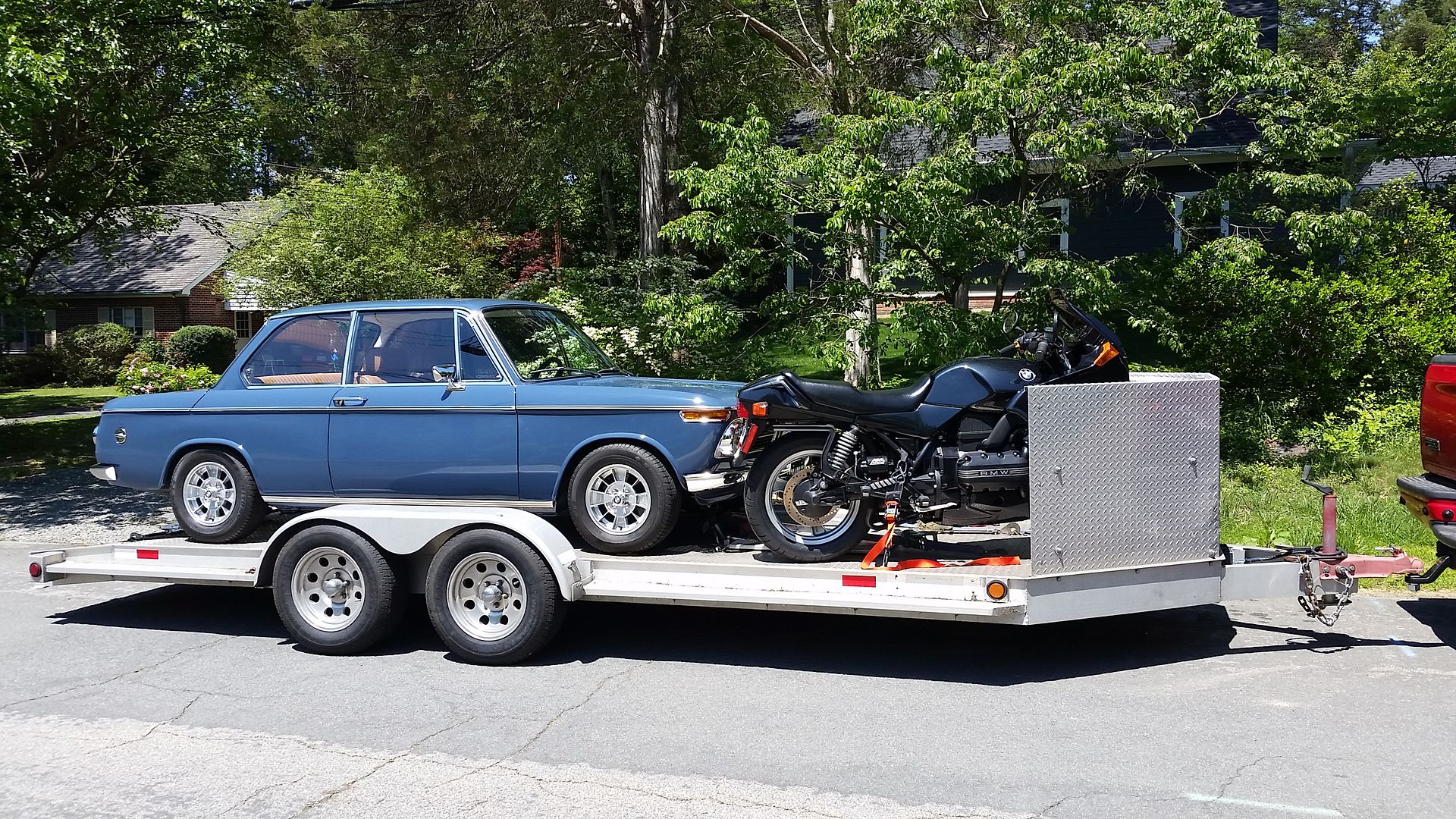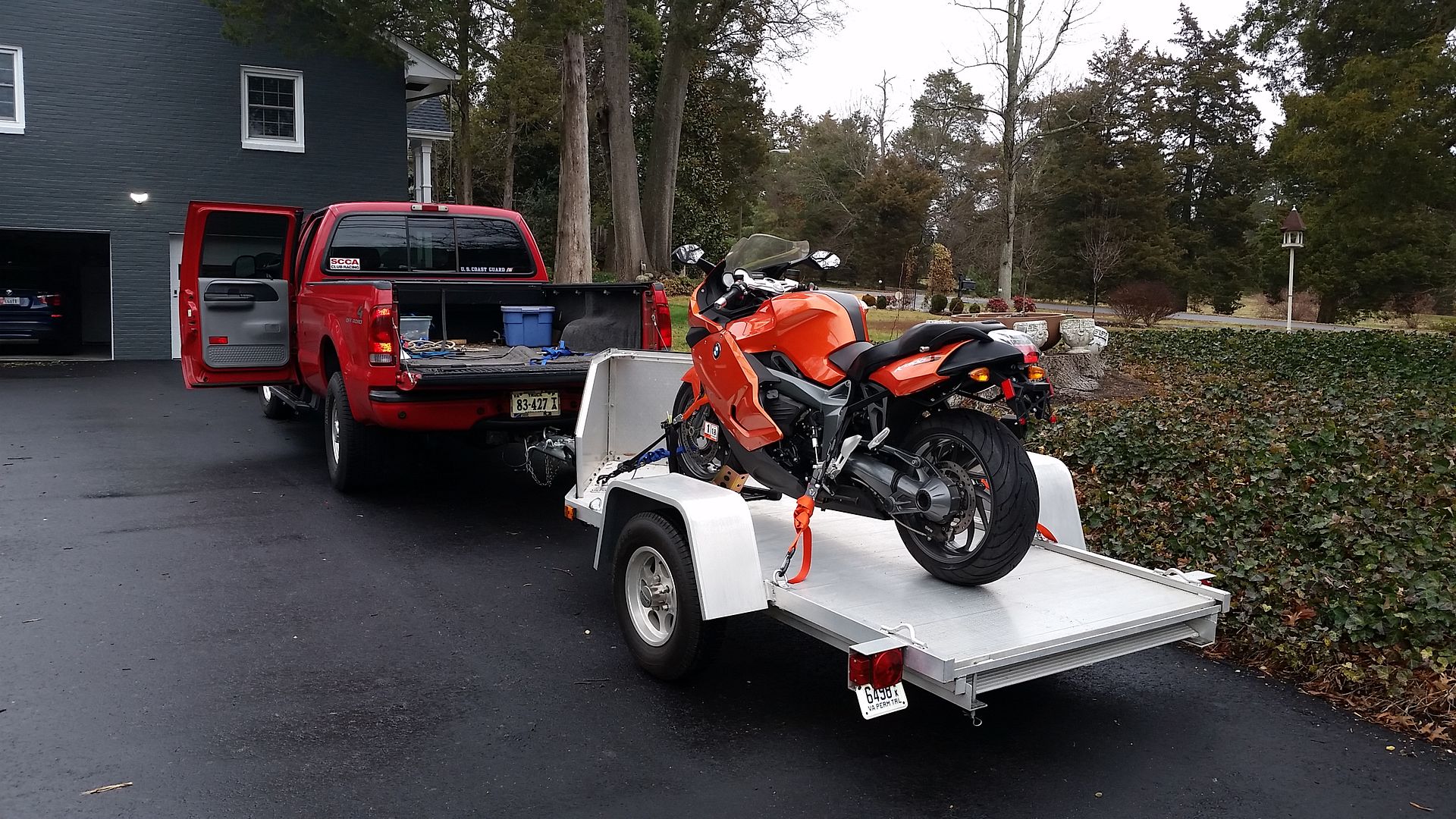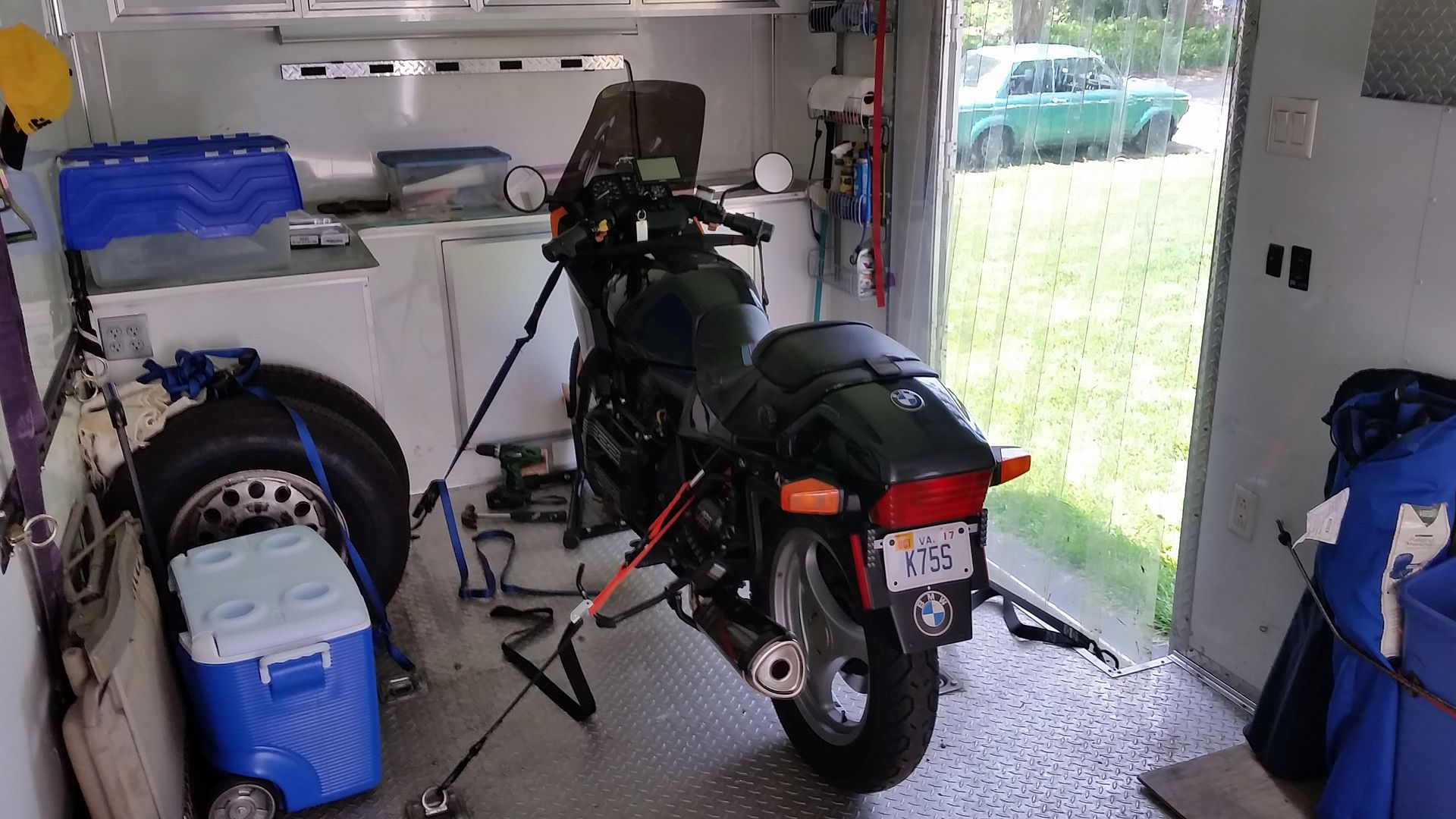Anyone who would like to share tips and advice regarding towing a trailer, I would appreciate it. We'll be in Salt Lake for the rally towing my K1200 on a borrowed Kendon trailer. My first effort at this, so any advice you can give to me and Pat (my beloved, a non-rider) would be appreciated. Thanks!!
Navigation
Install the app
How to install the app on iOS
Follow along with the video below to see how to install our site as a web app on your home screen.
Note: This feature may not be available in some browsers.
More options
-
Welcome, Guest! We hope you enjoy the excellent technical knowledge, event information and discussions that the BMW MOA forum provides. Some forum content will be hidden from you if you remain logged out. If you want to view all content, please click the 'Log in' button above and enter your BMW MOA username and password. If you are not an MOA member, why not take the time to join the club, so you can enjoy posting on the forum, the BMW Owners News magazine, and all of the discounts and benefits the BMW MOA offers?
-
Beginning April 1st, and running through April 30th, there is a new 2024 BMW MOA Election discussion area within The Club section of the forum. Within this forum area is also a sticky post that provides the ground rules for participating in the Election forum area. Also, the candidates statements are provided. Please read before joining the conversation, because the rules are very specific to maintain civility.
The Election forum is here: Election Forum
You are using an out of date browser. It may not display this or other websites correctly.
You should upgrade or use an alternative browser.
You should upgrade or use an alternative browser.
Trailering my K1200
- Thread starter chessare5
- Start date
lee
Debbie's Servant
Welcome to the site.
Do you have the K1200 with the brick engine or the slant 4 engine.
Let us know what year it is and the model. K1200RS, GT, or S?
Edit: I looked at your profile and see you have a 03 K1200 so it's a K1200RS or K1200GT.
This will help when someone comes along to suggest tie-down points.
Do you have the K1200 with the brick engine or the slant 4 engine.
Let us know what year it is and the model. K1200RS, GT, or S?
Edit: I looked at your profile and see you have a 03 K1200 so it's a K1200RS or K1200GT.
This will help when someone comes along to suggest tie-down points.
alancoles
Dress for fall & avoid it
Also, a good idea to let folks know what you will be using as a tow vehicle (make/model/year/engine). Mid-size and larger vehicles should be fine towing it as it looks like you'll have a combined weight of around 1,800 lbs~, some small vehicles can tow it but the smaller the vehicle, the more care is required to be safe.
I'm not very familiar with the K1200 other than having looked at them and some friends have them so can only give a general overview of what I've done for towing bikes. My R1150RT had a similar front-end and fairly well enclosed body work around it, so you may have the benefit of being able to tie-down using the telelever cross-brace. This means you don't have to use far less desireable method of compressing the suspension.
For me, I far prefer to tie a bike down at the fork brace and therefore not compress the suspension. Two straps going to the front corners of the trailer that a) pull the front wheel firmly snug against the wheel-chock and b) stabilize and support the bike left-to-right. I use tie-down straps on the rear wheel at the bottom (around a rim spoke) going forward and to the rear to keep the wheel from rotating and then use tie-downs at the top of the wheel (around a rim spoke) going to both sides to stabilize/support it left-to-right.
Using this method means that you do not need to use hardly any pressure on the tie-down straps, they just need to be snug to prevent any slop. People often get alarmed at this but the straps are just there to keep the wheels from moving. If they don't move (forward/back or left/right) then just like when you're riding the bike it stays put. No need to apply a lot of pressure left-to-right as long as the straps are snug any attemp to move to the left will be stopped by the right strap and vise-versa.
If you can't tie-down via the wheels and must compress the suspension then you need to have more pressure as suspension can compress and mess up your left-right strap tension.
Whatever method you use, it is always good to use small velcro straps or duct tape, etc., on your tie-down hooks to keep them securely attached in the event of a strap getting into a low tension or even loose situation. The trailer should do a good job of keeping weight-distribution correct (approx 10% of total weight should be on the tonge) for stable towing. Finally, keeping your top speeds low to moderate will help offset the addition of the trailer/bike on your car control, and remember to anticipate things to a greater degree (just like when you're riding your bike), to provide more time/distance for slowing down, turning, etc.
One last note - when I park overnight at a motel with a trailer and bike, I like to leave early so I can stop early and get a spot close to the entryway light of the hotel/motel. If they've got a wall that I can back the trailer up to (without being a nusiance) than that means potential theives need to steal the whole package. Don't try to tow with a bike cover on, it with be destroyed, but a cover for overnight parking keeps honest people honest and makes your bike less attractive than the next one to others.
I'm not very familiar with the K1200 other than having looked at them and some friends have them so can only give a general overview of what I've done for towing bikes. My R1150RT had a similar front-end and fairly well enclosed body work around it, so you may have the benefit of being able to tie-down using the telelever cross-brace. This means you don't have to use far less desireable method of compressing the suspension.
For me, I far prefer to tie a bike down at the fork brace and therefore not compress the suspension. Two straps going to the front corners of the trailer that a) pull the front wheel firmly snug against the wheel-chock and b) stabilize and support the bike left-to-right. I use tie-down straps on the rear wheel at the bottom (around a rim spoke) going forward and to the rear to keep the wheel from rotating and then use tie-downs at the top of the wheel (around a rim spoke) going to both sides to stabilize/support it left-to-right.
Using this method means that you do not need to use hardly any pressure on the tie-down straps, they just need to be snug to prevent any slop. People often get alarmed at this but the straps are just there to keep the wheels from moving. If they don't move (forward/back or left/right) then just like when you're riding the bike it stays put. No need to apply a lot of pressure left-to-right as long as the straps are snug any attemp to move to the left will be stopped by the right strap and vise-versa.
If you can't tie-down via the wheels and must compress the suspension then you need to have more pressure as suspension can compress and mess up your left-right strap tension.
Whatever method you use, it is always good to use small velcro straps or duct tape, etc., on your tie-down hooks to keep them securely attached in the event of a strap getting into a low tension or even loose situation. The trailer should do a good job of keeping weight-distribution correct (approx 10% of total weight should be on the tonge) for stable towing. Finally, keeping your top speeds low to moderate will help offset the addition of the trailer/bike on your car control, and remember to anticipate things to a greater degree (just like when you're riding your bike), to provide more time/distance for slowing down, turning, etc.
One last note - when I park overnight at a motel with a trailer and bike, I like to leave early so I can stop early and get a spot close to the entryway light of the hotel/motel. If they've got a wall that I can back the trailer up to (without being a nusiance) than that means potential theives need to steal the whole package. Don't try to tow with a bike cover on, it with be destroyed, but a cover for overnight parking keeps honest people honest and makes your bike less attractive than the next one to others.
Trailering
I have the GT and will be using a Honda Odessey as a tow vehicle. Tow capacity is 1500 total pounds, so there is more than adequate capacity for a 700 lb. bike and 300 lb trailer, I would think. Thanks!!
Also, a good idea to let folks know what you will be using as a tow vehicle (make/model/year/engine). Mid-size and larger vehicles should be fine towing it as it looks like you'll have a combined weight of around 1,800 lbs~, some small vehicles can tow it but the smaller the vehicle, the more care is required to be safe.
I'm not very familiar with the K1200 other than having looked at them and some friends have them so can only give a general overview of what I've done for towing bikes. My R1150RT had a similar front-end and fairly well enclosed body work around it, so you may have the benefit of being able to tie-down using the telelever cross-brace. This means you don't have to use far less desireable method of compressing the suspension.
For me, I far prefer to tie a bike down at the fork brace and therefore not compress the suspension. Two straps going to the front corners of the trailer that a) pull the front wheel firmly snug against the wheel-chock and b) stabilize and support the bike left-to-right. I use tie-down straps on the rear wheel at the bottom (around a rim spoke) going forward and to the rear to keep the wheel from rotating and then use tie-downs at the top of the wheel (around a rim spoke) going to both sides to stabilize/support it left-to-right.
Using this method means that you do not need to use hardly any pressure on the tie-down straps, they just need to be snug to prevent any slop. People often get alarmed at this but the straps are just there to keep the wheels from moving. If they don't move (forward/back or left/right) then just like when you're riding the bike it stays put. No need to apply a lot of pressure left-to-right as long as the straps are snug any attemp to move to the left will be stopped by the right strap and vise-versa.
If you can't tie-down via the wheels and must compress the suspension then you need to have more pressure as suspension can compress and mess up your left-right strap tension.
Whatever method you use, it is always good to use small velcro straps or duct tape, etc., on your tie-down hooks to keep them securely attached in the event of a strap getting into a low tension or even loose situation. The trailer should do a good job of keeping weight-distribution correct (approx 10% of total weight should be on the tonge) for stable towing. Finally, keeping your top speeds low to moderate will help offset the addition of the trailer/bike on your car control, and remember to anticipate things to a greater degree (just like when you're riding your bike), to provide more time/distance for slowing down, turning, etc.
One last note - when I park overnight at a motel with a trailer and bike, I like to leave early so I can stop early and get a spot close to the entryway light of the hotel/motel. If they've got a wall that I can back the trailer up to (without being a nusiance) than that means potential theives need to steal the whole package. Don't try to tow with a bike cover on, it with be destroyed, but a cover for overnight parking keeps honest people honest and makes your bike less attractive than the next one to others.
I have the GT and will be using a Honda Odessey as a tow vehicle. Tow capacity is 1500 total pounds, so there is more than adequate capacity for a 700 lb. bike and 300 lb trailer, I would think. Thanks!!
mlytle
Member
Hi Lee!
front straps hold it in the chock. rear straps with slight angle back stabilize and keep the bike on the trailer if there was a bad hard stop. i would never have all the straps in the same direction. gotta have diversity.
not shown except in the K13s pic (blue strap), but i also strap the front wheel tight directly to the front chock. wheel ain't coming out..
i am apparently just copying you on the bike selection!
PS - in those K12rs trailer pics, looks like open hook straps are being used. although pic is blury, also looks like rear straps are attached to the alum rear peg mounts, not the bike frame. big no-no. those mounts will bend/break off. since you had one Lee, you would know better than I if that is the case.
front straps hold it in the chock. rear straps with slight angle back stabilize and keep the bike on the trailer if there was a bad hard stop. i would never have all the straps in the same direction. gotta have diversity.
not shown except in the K13s pic (blue strap), but i also strap the front wheel tight directly to the front chock. wheel ain't coming out..
i am apparently just copying you on the bike selection!
PS - in those K12rs trailer pics, looks like open hook straps are being used. although pic is blury, also looks like rear straps are attached to the alum rear peg mounts, not the bike frame. big no-no. those mounts will bend/break off. since you had one Lee, you would know better than I if that is the case.
I bought a 2003 K1200RS from my uncle out in Colorado and rented a U-Haul trailer to go pick it up. YMMV, but this is what I did.
We couldn't find a way to tie down in the front such that we didn't end up with straps on the fairings with normal straps. So instead we use a strap designed to tie down the front of the bike using the handlebar grips. It is one strap with ratchets/hooks on both ends. In the middle are two sleeves, made to slip over the hand grips on either side. This moved the straps out enough from the body that it was easy to ratchet the front end down without getting anywhere near the tupperware. It pulled it into the chuck nicely.
For the back, I attached soft loops to the handles that the side cases hook/lock onto. I then used cam straps to pull the back end down and tight while my uncle sat on the bike to compress the suspension. The thing I found very interesting is that you bring these tie down forward in the trailer of where you hook them to the bike, not back. I assumed you would want to do it like a tent, but my uncle told me that was not the right way. You want the straps all pulling the bike towards the wheel chock on the front and down.
My uncle has been riding decades longer than I have been alive and I am in my 40s. And he has towed more bikes of more types than I will ever dream of (he used to work with a tour operator and ended up having to load a bunch of bikes in the back of trucks to get them somewhere they could be serviced). So I didn't dream of questioning anything he did when he was tying it down.
And the bike road beautifully from Colorado to Kansas City. No straps loosened (checked them every stop) and the bike didn't budge an inch. No damage to the handlebars, suspension, or the place I tied into on the back.
Good luck!
We couldn't find a way to tie down in the front such that we didn't end up with straps on the fairings with normal straps. So instead we use a strap designed to tie down the front of the bike using the handlebar grips. It is one strap with ratchets/hooks on both ends. In the middle are two sleeves, made to slip over the hand grips on either side. This moved the straps out enough from the body that it was easy to ratchet the front end down without getting anywhere near the tupperware. It pulled it into the chuck nicely.
For the back, I attached soft loops to the handles that the side cases hook/lock onto. I then used cam straps to pull the back end down and tight while my uncle sat on the bike to compress the suspension. The thing I found very interesting is that you bring these tie down forward in the trailer of where you hook them to the bike, not back. I assumed you would want to do it like a tent, but my uncle told me that was not the right way. You want the straps all pulling the bike towards the wheel chock on the front and down.
My uncle has been riding decades longer than I have been alive and I am in my 40s. And he has towed more bikes of more types than I will ever dream of (he used to work with a tour operator and ended up having to load a bunch of bikes in the back of trucks to get them somewhere they could be serviced). So I didn't dream of questioning anything he did when he was tying it down.
And the bike road beautifully from Colorado to Kansas City. No straps loosened (checked them every stop) and the bike didn't budge an inch. No damage to the handlebars, suspension, or the place I tied into on the back.
Good luck!
This thread- https://forums.bmwmoa.org/showthread.php?88430-U-Haul-motorycle-trailer&highlight=trailer+tie+down
had a lot of good info on tying down a bike on a trailer.
OM
had a lot of good info on tying down a bike on a trailer.
OM
mlytle
Member
We couldn't find a way to tie down in the front such that we didn't end up with straps on the fairings with normal straps. So instead we use a strap designed to tie down the front of the bike using the handlebar grips. It is one strap with ratchets/hooks on both ends. In the middle are two sleeves, made to slip over the hand grips on either side. This moved the straps out enough from the body that it was easy to ratchet the front end down without getting anywhere near the tupperware. It pulled it into the chuck nicely.
Good luck!
i used those same handle bar attachment things..... once. (shown in last pic in my post)
probably won't use them again. load on bars, load on throttle, load on heated grip parts. finding a way to attache to triple tree or cross bar much better.
i used those same handle bar attachment things..... once. (shown in last pic in my post)
probably won't use them again. load on bars, load on throttle, load on heated grip parts. finding a way to attache to triple tree or cross bar much better.
Well, I started thinking about that, but decided really it wasn't much more force on the handles that it would probably get when I was riding. It did absolutely no damage on the 500 mile plus trip.
Now if I was trailering the bike regularly I would probably work out a better system. But for the occasional trip I don't see the harm.
i used those same handle bar attachment things..... once. (shown in last pic in my post)
probably won't use them again. load on bars, load on throttle, load on heated grip parts. finding a way to attache to triple tree or cross bar much better.
Just went back and looked at your picture showing the similar strap. Same type, but looks like the loop that goes over the grip on yours was pretty small ( an inch or two wide? ). The sleeves on mine are a good six inches or so. So the load is spread all the way across the grips rather than a small portion of it. Not that your points may not have validity still. Just not completely comparing apples to apples.
I would do a "test-run" so as you can see and perhaps get the feel of how the Honda likes having a tail. I took a look at some Honda Odessey tow ratings and found 3500 lb tow ratings. One quick way I like to size up the possibles with towing is the size of the receiver hitch. If it's 2", you should be good to go.I have the GT and will be using a Honda Odessey as a tow vehicle. Tow capacity is 1500 total pounds, so there is more than adequate capacity for a 700 lb. bike and 300 lb trailer, I would think. Thanks!!
OM
One of us will move this thread to the Gear section in the future.
Enjoy the forum!
Gary
lee
Debbie's Servant
PS - in those K12rs trailer pics, looks like open hook straps are being used. although pic is blury, also looks like rear straps are attached to the alum rear peg mounts, not the bike frame. big no-no. those mounts will bend/break off. since you had one Lee, you would know better than I if that is the case.
Rick sent me the pictures when I had the K1200RS and had just bought my Aluma trailer.
Never did trailer it
Don't remember where he attached the rear straps and I agree the rear peg mounts look like they could snap easy.
The front hooks are attached to soft ties around the forks above the brace and he probably used something to keep the hooks from coming loose.
mlytle
Member
Just went back and looked at your picture showing the similar strap. Same type, but looks like the loop that goes over the grip on yours was pretty small ( an inch or two wide? ). The sleeves on mine are a good six inches or so. So the load is spread all the way across the grips rather than a small portion of it. Not that your points may not have validity still. Just not completely comparing apples to apples.
Mine had the long sleeves that fit over the entire grips.. like yours........
The only thing that I do differently when trailering from what I saw in the posted photos are the straps on the forks. I have four tie down points at the front of the trailer to allow two pairs of straps. If one strap should become loose, rather than the bike being able to fall to one side, the other pair will continue to hold the bike. Overkill, maybe, but if I didn't have bad luck, I doubt if I'd have any. 





mlytle
Member
The only thing that I do differently when trailering from what I saw in the posted photos are the straps on the forks. I have four tie down points at the front of the trailer to allow two pairs of straps. If one strap should become loose, rather than the bike being able to fall to one side, the other pair will continue to hold the bike. Overkill, maybe, but if I didn't have bad luck, I doubt if I'd have any.
there is no Kill, like OVERKill!
the more the merrier!
Similar threads
- Replies
- 11
- Views
- 625
- Replies
- 9
- Views
- 20K
- Replies
- 1
- Views
- 278

